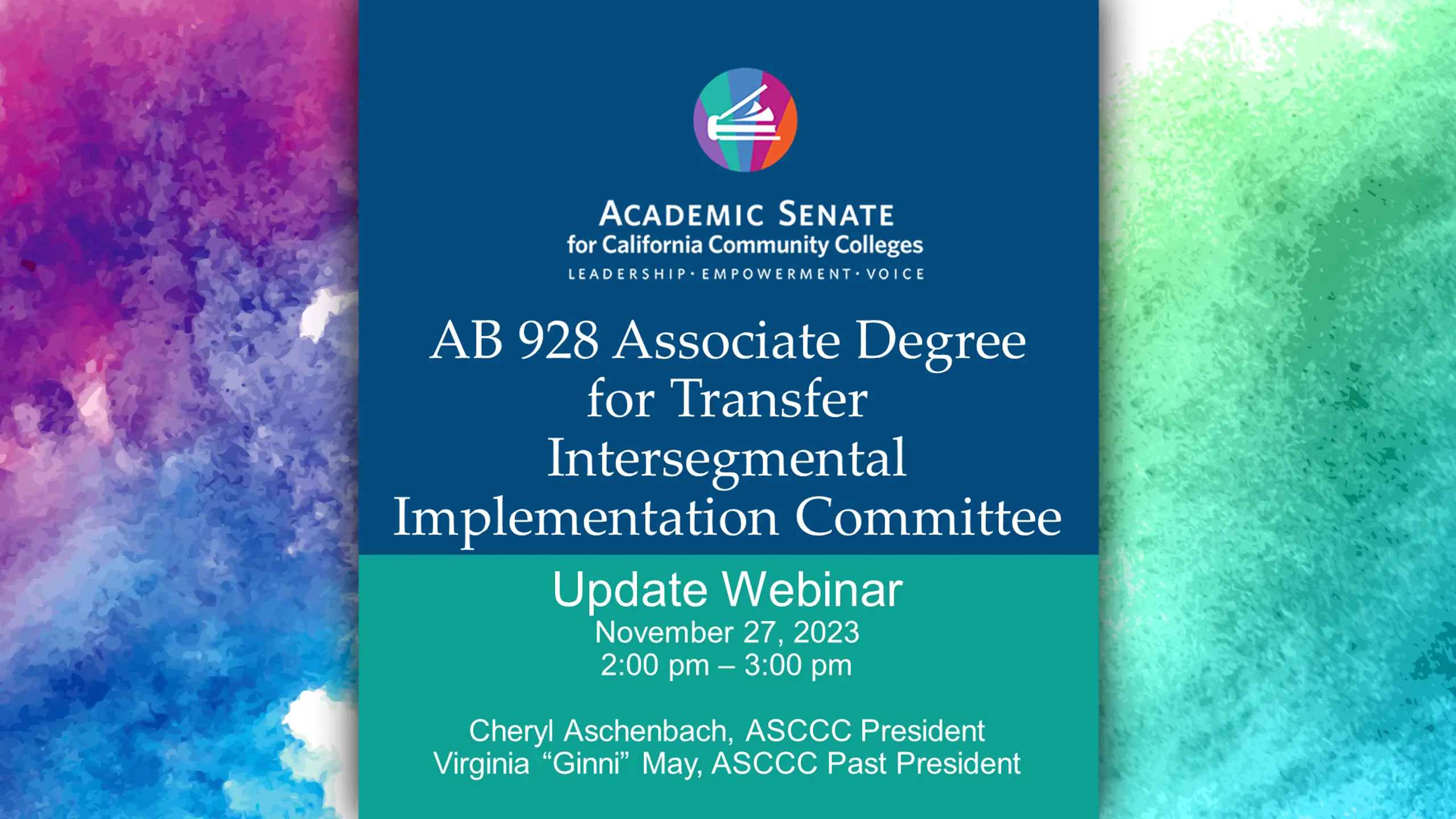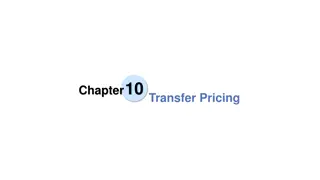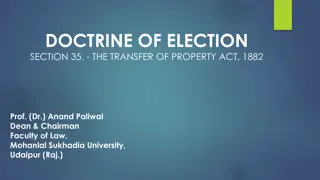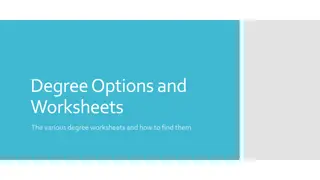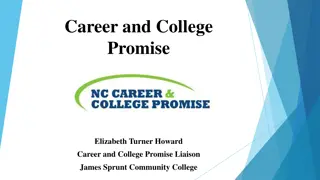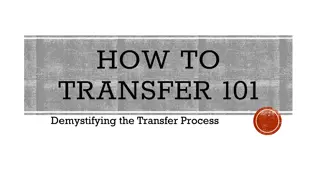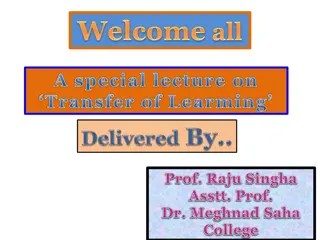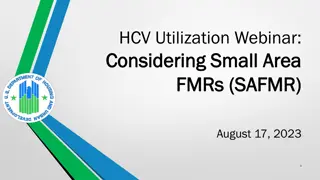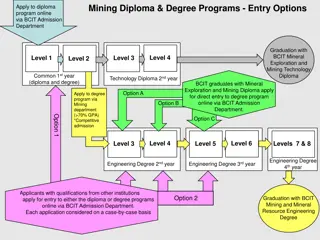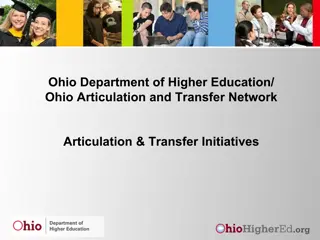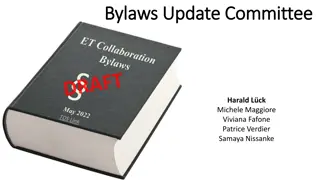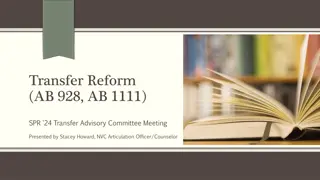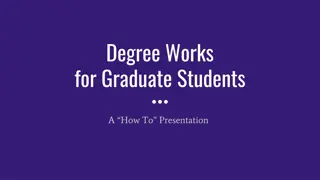AB 928 Associate Degree for Transfer Implementation Committee Update Webinar
Join the webinar to get the latest updates on AB 928 and the Associate Degree for Transfer Intersegmental Implementation Committee. Learn about the major components, goals, and progress of this important legislation.
Download Presentation

Please find below an Image/Link to download the presentation.
The content on the website is provided AS IS for your information and personal use only. It may not be sold, licensed, or shared on other websites without obtaining consent from the author.If you encounter any issues during the download, it is possible that the publisher has removed the file from their server.
You are allowed to download the files provided on this website for personal or commercial use, subject to the condition that they are used lawfully. All files are the property of their respective owners.
The content on the website is provided AS IS for your information and personal use only. It may not be sold, licensed, or shared on other websites without obtaining consent from the author.
E N D
Presentation Transcript
AB 928 Associate Degree for Transfer Intersegmental Implementation Committee Update Webinar November 27, 2023 2:00 pm 3:00 pm Cheryl Aschenbach, ASCCC President Virginia Ginni May, ASCCC Past President
Overview Review: AB 928 ADT Intersegmental Implementation Committee Review: AB 928 Draft Report Discussion / Q & A Version: November 2023 2
Review AB 928 (Berman, 2021) AB 928 ADT Intersegmental Implementation Committee
AB 928 (Berman, 2021) - Student Transfer Achievement Reform Act of 2021: Associate Degree for Transfer Intersegmental Implementation Committee. Signed into law on October 6, 2021 Major Components 1. Requires the Intersegmental Committee of Academic Senates (ICAS) to establish a singular lower division general education pathway. Cal- GETC: Done! 2. Establishes the Associate Degree for Transfer Intersegmental Implementation Committee. 3. Requires the CCCs to place students on ADT pathways. Guidance sent to colleges end of September 2023 (Memo ESS 23-41) 4. Considerations for up to an additional 6 units for STEM pathways. In progress AB 928 The Law 4
Primary entity charged with the oversight of the Associate Degree for Transfer (ADT) Ensure a reduction in the number of excess units accumulated by CCC students before transfer Eliminate repetition of courses at four-year postsecondary colleges and universities taken by CCC students who successfully transfer Increase the number of CCC students who transfer Enhance coordination and communication between four-year postsecondary colleges and universities and the CCCs AB 928 Committee webpage AB 928 Associate Degree for Transfer Intersegmental Implementation Committee 5
Membership: 16 members: 4 segments (CCC, CSU, UC, AICCU*) and DOE; 3 Academic Senates (CCC, CSU, UC) 3 Student Organizations (CCC, CSU, UC) Equity Focused Appointees Workforce Sector with expertise in STEM Meetings Met 6 times Oct 13, 2022 Sept 18, 2023 Next meeting is November 30 Scheduled to meet 5 times in 2024 AB 928 Committee Membership and Meetings *Association of Independent California Colleges and Universities 6
Charge for 2023: Goals: Identifying annual goals for increasing transfer rates in California and closing racial equity gaps in transfer outcomes to be adopted by the state. STEM: Proposing a new unit threshold for STEM degree pathways that meet the requirements for admission to the California State University and the University of California. Reengagement: Reengaging ADT earners who do not transfer or apply for transfer into a four-year postsecondary educational institution. AB 928 Committee Charge for 2023 7
Draft Report: Nov. 2023 Version What s new? What are the recommendations?
AB 928 Associated Degree for Transfer Intersegmental Committee Draft: Final Report Version: November 2023 September 18, 2023 Meeting the August 2023 version captured initial findings and considerations from the committee and subgroups Public comments considered: 9-19-2023 to 10-15-2023 10-15-2023 to 11-15-2023 November 30, 2023 Meeting the AB 928 Committee will vote on final recommendations Agenda Zoom (in agenda) Public Comment December 1, 2023 Draft due to Governor s Office of Research and Planning December 31, 2023 Final report due to Legislature AB 928 ADT Intersegmental Committee Draft: Report Version: November 2023 9
Draft Recommendations Editing still to take place for Accuracy of processes Feasibility Clarity AB 928 Committee Vote 10
Recommendation 1. Adopt and monitor the following goals, designed to prioritize first and foremost closing equity gaps by race and ethnicity in transfer outcomes: By 2030, close equity gaps by race and ethnicity in the outcomes of students who begin in the California Community Colleges (CCC) and seek to transfer; and By 2030, close equity gaps by race and ethnicity in the outcomes of students who begin in the CCC and seek to apply, be admitted, enroll and graduate from the University of California (UC) and California State University (CSU) systems. Recommendation 2. Adopt and monitor the following goal: To meet the state s 70% postsecondary credential attainment goal (set by Governor Newsom) by 2030, increase statewide attainment by 2% each year from the current baseline of 56% while closing equity gaps by race and ethnicity to ensure all of California s residents meet the 70% goal. AB 928 Draft Recommendations 1-4: Goals Recommendation 3. Adopt and monitor the following goal: By 2030, 100% of the entering CCC students who intend to (and meet the academic requirements for) transfer will successfully transfer (apply to transfer, be admitted, and enroll) and will complete a bachelor s degree within four years of transfer at any accredited non-profit institution in- or out-of-state. Recommendation 4. Adopt and monitor the following goal: By 2030, close regional opportunity gaps to access Associate Degree for Transfer (ADT) pathways by ensuring students can transfer in their region and in the major in which they earned their ADT. 11
Recommendation 5. Establish and resource an Intersegmental Course Articulation and Pathways Development infrastructure to oversee the process of course review, pathways development, and determinations of similarity, with intentional participation of faculty from CCC, CSU, UC and Association of Independent California Colleges and Universities (AICCU) member institutions to maximize the potential of the ADT and its guarantee of admissions at participating four-year universities. Recommendation 6. Retain the 60-unit requirement for ADTs while providing an option for up to an additional 6 units for high-unit STEM ADTs and require the submission of clear evidence and rationale for the higher units during the Transfer Model Curricula (TMC) approval process. AB 928 Draft Recommendations 5-7: STEM Recommendation 7. Require that by the end of the 2023-24 academic year, TMC drafts are in place for each of Engineering, Biology, Chemistry, Mathematics, Environmental Science, Physics, and Computer Science pathways that prepare students for transfer to both the CSU and UC systems and other four-year institutions that choose to participate (such as members of AICCU and Historically Black Colleges and Universities (HBCUs) currently engaged with the CCCCO). Should a discipline or major not yield to a single transfer pathway, clear rationale and evidence on why separate pathways are needed must be provided. 12
Recommendation 8. Set a deadline that the CCCs must adopt the TMCs (as created in Recommendation 7) and create ADTs, and encourage the CSU and UC systems, and other four-year institutions that choose to participate (such as members of AICCU and HBCUs currently engaged with the CCCCO), to accept those ADTs for transfer so that students are accessing the ADTs by fall of 2026. Recommendation 9. Make clear that general education flexibility for STEM pathways is allowed and may be required for the creation of equitable pathways in some STEM programs. AB 928 Draft Recommendations 8-12: STEM Recommendation 10. To support equitable student success in STEM pathways, invest in the scaled implementation of culturally responsive student supports and evidence-based academic/pedagogical improvements. Recommendation 11. Require transparency concerning membership and composition of the Faculty Discipline Review Groups (FDRGs) and other intersegmental curriculum groups. Recommendation 12. In light of the relevance of AB12913 to the goals of the AB928 Committee, require AB1291 be implemented in meaningful collaboration with the CCCs and that pathways developed in response to AB1291 adhere to the recommendations of the AB928 Committee regarding STEM TMCs. 13
Recommendation 13. Invest in the creation, and assign responsibility for implementation, of a Transfer Reengagement Initiative for Associate Degree Holders (TRIAD), a comprehensive plan organized into two overarching areas of focus: Strategies to reduce the number of students who get close to transfer and do not transfer or apply to transfer: Build a universal student application process; Identify, monitor and make visible the students of focus; Streamline processes and remove unnecessary barriers; Study the impact of financial aid; and Build a regional infrastructure for coordinating admissions (and redirecting if needed) across segments and online offerings to ensure placebound students can stay in their preferred region. Strategies to reengage students who already hold the ADT and did not transfer or apply to transfer: Launch a reengagement campaign that is carefully designed for success and inclusive of: Reengagement scholarships that provide reduced or free tuition and fees for returning students; Bridge programs that support students as they reenter postsecondary education; Easily accessible coaching services so students can quickly and easily receive customized support; and Funding levers and metrics that can incentivize institutions focus on increased student enrollment, persistence, and completion. AB 928 Draft Recommendation 13: Re-engaging ADT Earners 14
Recommendation 14. Permanently establish within state structures, and resource with on-going funding, a Higher Education Intersegmental Council. This Council s make-up should include students, senior administrative and academic senate leaders from all of the segments, K12 representatives, workforce experts and equity advocates (mirroring in many ways the representation on the AB928 Committee), and should seek to meet the following goals: Develop a detailed plan, that outlines the roles and responsibilities of each segment, for how the state will increase credential production and transfer attainment to meet the state s 70% attainment goal, while closing equity gaps, particularly by race and ethnicity, income and region; AB 928 Draft Recommendation 14: Overarching Needs Build and resource statewide infrastructure for intersegmental coordination and collaboration, breaking down existing siloes; Create a new venue for addressing policy barriers, responding to new policies, and aligning and streamlining resources and investments; Assess educational program alignment to workforce demand and engage industry to align education and training programs; Develop a shared definition of regional service areas and alignment of equitable opportunity; Deepen understanding of student affordability through collaboration with critical entities such as the California Student Aid Commission (CSAC) and aligned affordability efforts such as college savings accounts and Free Application for Federal Student Aid (FAFSA) for All; and Provide oversight for efforts recommended by the AB928 Committee, such as the Intersegmental Course Articulation and Pathways Development infrastructure, the monitoring of goals, and the TRIAD. 15
Recommendation 15. Invest in the accelerated completion of the Cradle-to-Career data system, with active participation of representatives from the four segments of higher education to inform data and information needs.4 Ensure that the data system can provide ongoing monitoring of the goals and activities outlined by the AB928 Committee, and provide, at a minimum, data and analysis that is finely disaggregated by race and ethnicity (e.g., disaggregated by subpopulation within groups such as Asian), income, and region of at least the following metrics and areas of analysis: Outcomes for transfer students who start at community colleges, including data on who gets prepared for transfer, finishes the ADT, applies to transfer, is accepted for transfer, enrolls and then completes the bachelor's degree (and other credentials); Outcomes for students who start in four-year institutions and transfer to other institutions (e.g., to community college colleges, other four-year institutions, etc.), including data on who applies to transfer, is accepted for transfer, enrolls and then completes credentials; Total time and units to degree for transfer students; Labor market outcomes for transfer students; The effects of impaction/redirection; Intra- and inter-regional transfer patterns; Intersectional identities of transfer students and related success patterns; and Credits that are unusable or repeated in the transfer process. AB 928 Draft Recommendation 15: Overarching Needs 16
Recommendation 16. Commission a comprehensive needs and opportunities landscape analysis of regional workforce and educational needs, resources, and gaps. AB 928 Draft Recommendations 16-17: Overarching Needs Recommendation 17. Provide ongoing, permanent funding for the holistic strategies needed to ensure that marginalized and historically minoritized students succeed at the levels required to deliver on the promise of equitable economic mobility and meet the state s 70% attainment goal, with intentional monitoring of impact to ensure they are improving outcomes and achieving equity. 17
Getting Ready College/District: Affirm college and district curriculum approval processes Consider an expedited yet thorough process for the batching of curriculum, conditions for expedited processes Curriculum Committee/Academic Senate: Ensure curriculum approval processes are well-established, understood, and followed Work with administration to make sure resources (people and funding) are adequate for the volume of work expected Department: Begin reviewing your curriculum from a global perspective how do GE/majors courses align with such courses at other colleges? Statewide: Encourage faculty to participate in volunteer opportunities. Complete Volunteer for Statewide Service form Participate in Discipline Input Groups, share opportunities to participate with colleagues Respond to faculty surveys for vetting of processes, descriptors, and such 18
Questions? Thank You!! 19
